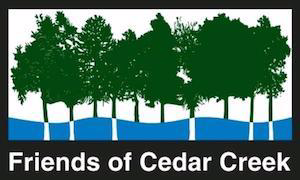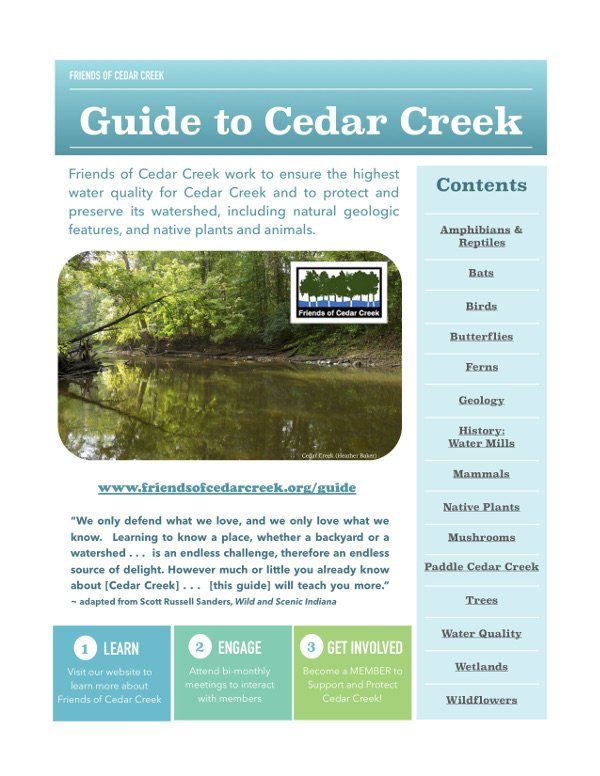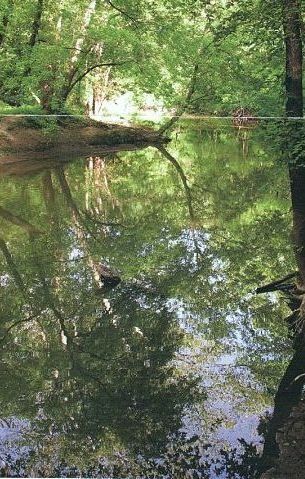Guide to Cedar Creek
Discovering WildflowersMary Anna Feitler
Blackeyed Susan,
Rudbeckia hirta (Heather Baker)
The Cedar Creek valley, part of Indiana’s Central Till Plain Natural Region, has good growing conditions for wild plants: glaciated terrain with generally forested vegetation, often poor drainage (clay soils intermixed with gravels from moraine deposits), temperatures from -20F to 90F, yearly moisture averaging 38.3 inches.
The Cedar Creek region is now considered to be in USDA Hardiness Zones 6a and 6b. The minimum temperature is now higher than mid 20th century minimum temperatures. As a result, we can expect warmer weather plants from further south to survive winters in the Cedar Creek area. As the climate changes and temperatures warm, some native plants we now see only occasionally may become more common, and seasons will be extended: earlier spring and later fall. While suggested blooming times will be relatively similar, we can expect to see different flowers, even different weather and rain patterns.
When we can identify and name specific wildflowers to look for in each season, we are more likely to find, enjoy, and protect them. So have fun learning both English and (sometimes quirky-sounding) Latin names as you identify these wildflowers in the diverse woods and meadows of the Cedar Creek valley. Children also like learning these names (and may find the wildflowers faster than you can). Be sure to explain why wildflowers must not be picked.
Click on the common wildflower names to view a variety of online resources!
White native flowers - spring
- Bloodroot, Sanguinaria canadensis
- Canada Violet, Viola canadensis
- Chickweed, Stellaria media
- Cut-leaved Toothwort, Dentaria laciniata
- Dutchman's Breeches, Dicentra cucullaria
- False Solomon's Seal, Similacina racemosa
- Goldenseal, Hydrastis canadensis
- Large-flowered Trillium, Trillium grandiflorum
- Mayapple, Podophyllum peltatum
- Rue Anemone, Anemonella thalictroides
- Shepherd's Purse, Capsella bursa-pastoris
- Spring Cress/Bitter Cress, Cardamine bulbosa
- Star Chickweed, Stellaria pubera
- Squirrel Corn, Dicentra canadensis
- Wood Anemone, Anemone quinquefolia
Large-flowered Trillium (Carol Roberts)
White native flowers - late spring to early summer
- Arrowwood, Viburnum dentatum (shrub)
- Bedstraw/Cleavers/Goosegrass, Galium aparine
- Black Chokeberry, Pyrus melanocarpa (shrub)
- Common Strawberry, Fragaria virginiana
- Early Meadow Rue, Thalictrum dioicum
- Maple-leaved Viburnum, Viburnum acerifolium (shrub)
- Miterwort, Mitella diphylla
- Poison Ivy, Rhus radicans (vine, skin irritant!)
- Smaller Pussytoes, Antennaria neodioica
- Sweet Cicely, Osmorhiza claytoni
- Thyme-leaved Speedwell, Veronica serpyllifolia
- Virginia Waterleaf, Hydrophyllum virginianum
- White Baneberry, Actaea pachypoda
- White Clover, Trifolium repens (note: non-native)
- White Sweet Clover, Melilotus alba
- Whitlow Grass, Draba verna
- Wild Raisin/Witherod, Viburnum cassinoides (shrub)
Eradicate these non-native (white/flowering) invasives:
- Garlic Mustard, Alliaria petiolata
- Japanese Honeysuckle vine, Lonicera japonica
- Multiflora Rose, Rosa multiflora
White native flowers - summer
- Black Cohosh/Bugbane, Cimicifuga racemosa
- Bladder Campion, Silene cucubalus
- Boneset, Eupatorium perfoliatum
- Buttonbush, Cephaleanthus occidentalis (shrub)
- Catnip, Nepeta cataria
- Elderberry, Sambucus canadensis (shrub)
- Common Moonseed, Menispermum canadense (vine)
- Common Nightshade, Solanum americanum
- Enchanters Nightshade, Circaea quadrisulcata
- Honeywort/Wild Chervil, Cryptotaenia canadensis
- Horse Nettle, Solanum carolinense
- Moth Mullein, Verbascum baltaria
- Peppergrass/Poor-man's Pepper, Lepidium virginicum
- Pokeberry, Phytolacca americana
- Queen Anne's Lace/Wild Carrot, Daucus carota
- Rattlesnake Master, Eryngium yuccafolium
- Staghorn Sumac, Rhus typhina (shrub)
- Stickseed, Hackelia virginiana
- Thimbleweed, Anemone virginiana
- Turtlehead, Chelone glabra
- Virginia Knotweed, Polygonum virginianum
- Virgin's Bower, Clematis virginiana (vine)
- Water Hemlock, Circuta maculata (poisonous)
- White Snakeroot, Eupatorium rugosum
- White Vervain, Verbena uticifolia
- Wild Balsam Apple/Wild Cucumber, Echinocystis lobata (vine)
Yellow flowers - spring
- Coltsfoot, Tussilago farfara
- Common Dandelion, Taraxacum officinale
- Common Winter Cress, Barbarea vulgaris
- Lesser Celandine/Creeping Buttercup, Chelidonium majus (Invasive!)
- Marsh Marigold/Cowslip, Caltha palustris
- Pussy Willow, Salix discolor (shrub)
- Spicebush, Lindera benzoin (shrub)
- Wood Poppy/Celandine Poppy, Stylophorum diphyllum
- Yellow Lady's Slipper, Cypripedium calculus
Yellow flowers - late spring to early summer
- Butter-and-eggs, Linaria vulgaris
- Coltsfoot, Tussilago farfara
- Common Buttercup, Ranunculus acris
- Common Cattail, Typha latifolia
- Common Cinquefoil, Potentilla simplex (trailing plant)
- Golden Ragwort, Senecio aureus
- Lance-leaved Coreopsis/Tickseed, Coreopsis lanceolata
- Marsh Marigold/Cowslip, Caltha palustris
- Trout Lily/Dogtooth Violet, Erythronium americanum
- Yellow Hawkweed, Hieracium pratense
- Yellow Wood Sorrel/Sour Grass, Oxalis europaea (non-native)
Yellow flowers - summer
- Birdsfoot Trefoil, Lotus corniculatus
- Black-eyed Susan, Rudbeckia hirta
- Clammy Ground Cherry, Physalis heterphylla
- Common Buttercup, Ranunculus acris
- Common/Great Mullein, Verbascum thapsus
- Evening Primrose, Oenothera biennis
- Goldenrod, Solidago astereae
- Jewelweed/Pale Touch-me-not, Impatiens pallida
- Moneywort, Lysmachia nummularia (trailing)
- Prairie Coneflower, Ratibida pinnata
- Purslane, Portulaca oleracea
- Spiny-leaved Sow Thistle, Sonchus asper
- Velvetleaf, Abutilon theophrasti
- Wild Lettuce, Lactuca canadensis
- Wild Senna, Cassia hebecarpa
- Yellow Flag, Iris pseudacorus
Orange flowers - summer
- Canada Lily, Lilium canadense
- Daylily, Hemerocallis fulva (non-native)
- Jewelweed/Spotted Touch-me-not, Impatiens capensis
- Orange Hawkweed, Hieracium aurantiacum
- Wood Lily, Lilium philadelphicum
Red flowers- spring
- Wild Columbine, Aquilegia canadensis
Red flowers - summer
- Bee Balm/Oswego Tea, Monarda didyma
- Cardinal Flower, Lobelia cardinalis
Red-brown flowers - spring
- Jack-in-the-Pulpit, Arisaema triphyllum
- Nodding Trillium, Trillium cernuum
- Skunk Cabbage, Symplocarpus foetidus
- Toadshade/Sessile, Trillium Trillium sessile
- Wild Ginger, Asarum canadense
Round-lobed hepatica (Carol Roberts)
Pink flowers - spring
- Round-lobed Hepatica, Hepatica americana
- Shooting Star, Dodecatheon media
- Spring Beauty, Claytonia virginica
- Wild Geranium, Geranium maculata
Pink flowers - summer
- Canada Thistle, Circium arverse (non-native, invasive)
- Deptford Pink, Dianthus armeri
- Herb Robert, Geranium robertianum
- Purple Coneflower, Echinacea purpurea
- Spotted Joe-Pye Weed, Eupatorium maculatum
Purple flowers - summer
- New York Ironweed, Vernonia noveboracensis
Lavender flowers - late spring
- Monkeyflower, Mimulus ringens
- Wild Bergamot, Monarda fistulosa
Blue flowers - spring
- Bluets, Houstonia caerulea
- Common Blue Violet, Viola papilionacea
- Dog Violet, Viola conspersa
- Ground Ivy/Gill-over-the-ground, Glechoma hederacea (invasive)
- Long-spurred Violet, Viola rostrata
- Periwinkle, Vinca minor (extremely invasive)
- Round-lobed Hepatica, Hepatica americana
- Spring Larkspur, Delphinium tricorne
- Virginia Bluebells, Mertensia virginica
- Wild Blue Phlox, Phlox divaricata
Blue flowers - late spring
- Chicory, Cichorum intybus
- Great Lobelia, Lobelia siphilitica
Wild geranium (Carol Roberts)
Green flowers - spring
- Ginseng, Panax quinquefolium
- Green Dragon, Arisaema dracontium
- Jack-in-the-Pulpit, Arisaema triphyllum
- Lamb's Quarters/Pigweed, Chenopodium album
- Smooth Solomon's Seal, Polygonatum biflorum
Green flowers - late spring to early summer
- Carrion Flower, Smilax herbacea (vine)
- Common/Broad-leaved Plantain, Plantago major
- Giant/Great Ragweed, Ambrosia trifida
- Narrow-leaved/English Plantain, Plantago lanceolata
- Stinging Nettle, Urtica dioica
Green flowers - late summer to fall
- Climbing False Buckwheat, Polygonum scandens (vine)
- Fireweed/American Burnweed, Erechtites hieracifolia
More to Explore . . .
- Ecoplexity. http://www.ecoplexity.org.
- "Goldenrod." Carol Gaham. The Fox Tale. Vol. 41, Issue 3. Fox Island Alliance. http://foxislandalliance.org.
- The Friends of the Wildflower Garden, Inc. http://www.friendsofthewildflowergarden.org.
- Indiana Plant & Wildflower Society. http://www.inpaws.org.
- Lady Bird Johnson Wildflower Center. https://www.wildflower.org.
- Missouri Botanical Garden. http://www.missouribotanicalgarden.org.
- University of Michigan College of Literature. http://climbers.lsa.umich.edu.
- Urban Ecology Center.
http://urbanecologycenter.org.
- USDA Plant Database. https://plants.usda.gov.
- Wildscreen USA. http://www.arkive.org.





